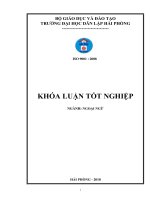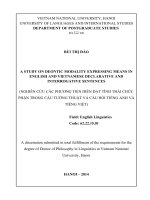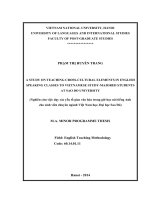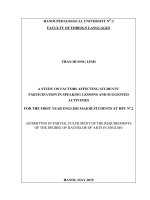A study on english – vietnamese cross-cultural communication in table seating arrangements
Bạn đang xem bản rút gọn của tài liệu. Xem và tải ngay bản đầy đủ của tài liệu tại đây (1.94 MB, 10 trang )
A study on english – vietnamese cross-cultural
communication in table seating arrangements
Trần Thị Thanh Huyền
Trường Đại học Ngoại Ngữ
Luận văn ThS. Chuyên ngành: English Linguistics; Mã Số: 60 22 15
Người hướng dẫn: Prof. Nguyễn Quang, Ph.D
Năm bảo vệ: 2010
Abstract: Based on the theoretical background of culture, communication and cross-cultural
non-verbal communication, this study aims at identifying the basic types of table shapes which
are square, round and rectangular, clarifying the meaning of four seating positions, namely
corner, cooperative, competitive-defensive and independent positions, investigating the use of
different seating arrangements in class in the two cultures: English and Vietnamese. Special
emphasis is therefore given to:The use of different table shapes in the office;The choice of
seating positions in different situations; Frequency of using seating arrangements in the
classroom by teachers; The findings drawn from data analyses are discussed with the hypotheses
given earlier in view. They provide evidence that Vietnamese and English native speakers share
some common choices of seating positions because the messages behind the positions are nearly
the same in the two cultures. Differences are mostly found in the reference point of
proportionality. In addition, a number of implications and suggestions are also made by the thesis
author to help take the full advantage of class seating arrangements and therefore achieve their
lesson targets as well as improve students’ learning abilities.
Keywords: Tiếng Anh; Giao tiếp; Giao văn hóa; Tiếng Việt
Content:
vii
Table of contents
CERTIFICATE OF the ORIGINALITY OF STUDY PROJECT REPORT iii
ACKNOWLEDGEMENTS iv
Abstract v
Lists of tables and figures vi
Table of contents vii
Part i: introduction 1
1. Rationale 1
2. Aims of the study 2
3. Scope of the study 2
4. Methodology 3
5. Description of the questionnaire 3
6. Description of the informants 4
7. Design of the study 5
Part II: Development 6
CHAPTER 1: THEORETICAL BACKROUND 6
1.1. What communication? 6
1.2. What non-verbal communication? 8
1.3. What table seating arrangement? 8
CHAPTER 2: SEATING ARRANGEMENT AS NON-VERBAL COMMUNICATION10
2.1. Table shapes 10
2.1.1. Square tables 10
2.1.2. Round tables 12
2.1.3. Rectangular tables 14
2.2. Table seating positions 16
2.2.1. Corner position 17
2.2.2. Cooperative position 18
2.2.3. Competitive – Defensive position 19
viii
2.2.4. Independent position 20
2.3. Seating arrangements 21
2.3.1. Desk-row 22
2.3.2. Cluster 24
2.3.3. Circle or semi-circle 25
2.3.4. Table-row 26
2.3.5. Pairs 27
2.3.6. Activity zones 29
CHAPTER 3: FINDINGS AND DISCUSSION 30
3.1. Data analysis 30
3.1.1. Use of table shapes 30
3.1.2. Use of table seating positions 30
3.1.3. Frequency of using seating arrangements 36
3.2. Major similarities and differences 38
PART III: CONCLUSION 42
1. Conclusion 42
2. Suggestions for further study 43
References 44
Appendices I
1
Part i: introduction
1. Rationale
Language is the basic form of communication between human beings and in a society.
As it is the basic form, it is also the most developed. We cannot communicate in any real sense
without language, other than through gestures. However, we do communicate through some
non-verbal forms called non-verbal communication including gestures, postures, facial
expressions, touching behavior, etc. Non-verbal communication occupies up to 90 percent of
our message and therefore plays an important role in our life. But it is observed that there are
non-verbal differences across cultures that may be the source of confusion for foreigners.
Thus, it is essential that the study of non-verbal communication be paid more attention to.
It is clear that where people seat others or where they sit on their own can affect the
outcome of a communication encounter. There is a "seating" language. People can create the
illusion of power or equality in their relationship-building efforts by where they sit and where
they seat others at meetings, conferences and after-hours events. Also, aspects of people’s
attitude towards others can be revealed in the position they take in relation to each other.
Indeed, the environment may have an effect on the position chosen. Apparently,
seating positions in the public bar of a hotel can vary from the seating positions taken in a
high-class restaurant and different seating behaviors can be observed. For instance, intimate
couples prefer to sit side-by-side wherever possible, but in a crowded restaurant where the
tables are close together, this is not possible and the couples are forced to sit opposite each
other in what is normally a defensive position. Hence, everyone should be aware of the
meaning of different positions to act in a proper way.
Moreover, the way teachers organize tables and seats in their class also has influence
on the effectiveness of the lesson, especially in language classroom. It is necessary for native
language teachers as well as Vietnamese ones to be well aware of that so as to take the best
advantage of class seating arrangements.
2
For the above reasons, ‘A Study on English – Vietnamese Cross-Cultural
Communication in Table Seating Arrangements’ is worth considering. With an effort to raise
the awareness of people in general and of teachers in particular of ‘something around the
table’, this area of non-verbal communication is chosen as the topic of the author’s study.
2. Aims of the study
The research is conducted:
To study different types table shapes;
To identify the meanings of basic table seating positions;
To investigate suitable seating arrangements used in classroom;
To compare and contrast the use of different types of seating positions in various
situations of the two cultures for the discovery of the similarities and differences in the
ways English and Vietnamese people seat others and sit themselves.
3. Scope of the study
In this study, three basic types of table shapes which are square, round and rectangular
are mentioned, but the survey will be narrowed down to table shapes in the office setting only.
Four kinds of seating positions including corner, cooperative, competitive-defensive
and independent are identified in this study. As the findings will be limited if attention is paid
only to academic and office settings, public setting is thus included in this part.
Seating arrangements vary greatly in the classroom. That is the reason why the author
only focuses on the statistics of how teachers seat their students and tables in learning
environment.
As age and gender of the informants do not contribute significantly in the data
analysis, the author decides to ignore them and focuses only on the informants’ nationality and
occupation.
3
4. Methodology
In order to achieve the aims set above, the major method to be employed is
quantitative. In addition, contrastive analysis is also used. All the considerations, comments
and conclusions in the thesis are largely based on the following methods:
Reference to publications
Survey questionnaires
Statistics, descriptions and analysis of data
Consultations with supervisor
Personal observations
Discussions with Vietnamese and foreign colleagues
5. Description of the questionnaire
The survey questionnaire consists of 4 questions in which the informants are requested
to tick (√) to the table shapes, seating positions and seating arrangements they think
appropriate. The 4 questions cover three aspects of the study: question 1 - table shapes,
questions 2 and 3 - seating positions and question 4 - seating arrangements. The questionnaire
has two versions, one in English for the English native informants and the other in Vietnamese
for the Vietnamese informants.
In the first question, the informants are asked to tick (√) to the type(s) of table that
is/are the most commonly used in the office.
Among the four most common seating positions including corner, cooperative,
competitive – defensive and independent positions, the informants are asked to tick (√) to the
most widely used in different settings (academic setting, office setting and public setting).
They are also requested to choose appropriate seating positions in different situations. The
situations are as follows:
4
Situation 1: When you interview Lee
Situation 2: When you persuade Lee
Situation 3: When you discuss with Lee
Situation 4: When you shout at Lee
Situation 5: When Lee is your boss and you are presenting to him
Situation 6: When you confide in Lee
Situation 7: When you do not know Lee
Situation 8: When you do not wish to contact with Lee
Situation 9: When Lee is angry with you and you want to make it up with him
Situation 10: When you want to get acquainted with Lee
(Supposing that Lee is the person you are talking with and he is taking a permanent seat)
In the last question, the informants are asked about the frequency of seating
arrangements used in class in their countries. Types of seating arrangements consist of desk-
row, clusters, circle/ semi-circle, table-row, pairs and activity zones.
Because of its limitations, the thesis should only be regarded as a preliminary study
and the result is believed to be tentative and suggestive.
6. Description of the informants
In this study, the survey questionnaires are administered to two groups of informants.
The first group is the Vietnamese who are living in Hanoi, Vietnam. 60 questionnaires are
delivered to them and 50 of the completed questionnaires are chosen for analysis. The second
5
group is English native speakers who are living and working in Vietnam as well as some
English-speaking countries such as the US, Australia, England and Canada. 50 questionnaires
are delivered to them directly or via e-mails, and then 50 completed ones are received.
Only teachers, students and staff officers are chosen as informants because the study
mostly confines itself to academic and office settings.
7. Design of the study
This study consists of three main parts:
PART I: INTRODUCTION
All the academic routines required for an M.A thesis are presented.
PART II: DEVELOPMENT
This is the focus of the study and is composed of three chapters.
Chapter 1: Theoretical background
Chapter 2: Seating arrangement as non-verbal communication
Chapter 3: Findings and discussion
PART III: CONCLUSION
44
References
In English
1. Alexandra Ramsden (12/16/99) Seating Arrangements. University of Delaware.
2. Do Thi Mai Thanh (2000) Some English – Vietnamese Cross Cultural Differences in
Requesting. M.A Thesis, VNU-CFL.
3. Doff, A. (1988) A Training Course for Teachers. Britain: Cambridge University Press.
4. Fotitch, T. (1961). Teaching Foreign Languages in the Modern World. Washington:
The Catholic University of America Press.
5. Hall, E.T. (1959) Silent Language. Doubleday & Co. New York.
6. Hybels, S. & Weaver II, R.I. (1992) Communicating Effectively. USA: McGraw – Hill,
Inc.
7. Knapp, M. & Hall, J. (1997) Nonverbal Communication in Human Interaction.
Harcourt Brace College Publisher, Orlando, USA.
8. Levine, D.R. & Adelman, M.B. (1982) Beyond Language – Intercultural
Communication for English as a Second Language. Prentice-Hall, Inc., Englewood
Cliffs, New Jersey.
9. Nguyen Quang (1998) Cross-cultural Communication. CFL – Vietnam National
University – Hanoi.
10. Nicole Cusick (12/16/99) Typical Classroom Seating Arrangements in US Elementary
Schools. University of Delaware.
11. Phan Thi Van Quyen (2001) Some English – Vietnamese Cross Cultural Differences in
Refusing a Request. M.A Thesis, VNU-CFL.
12. Saville-Troike, M. (1986) Teaching English as a second culture. In R. Crymes & W.
Norris (Eds.), ON TESOL ’74. Washington: TESOL.
13. Suzanne Pitner (Jun 2,2009) How to Plan a Classroom Seating Arrangement.
14. Verderber R. F. (1993) Communicate. Belmont, California: Wadsworth, Inc.
45
15. Wright, A. (1987) How to Communicate Successfully. Cambridge University Press,
Cambridge.
In Vietnamese
16. Nguyễn Quang (2002) Giao tiếp và Giao tiếp Giao văn hóa. NXB Đại học Quốc Gia
Hà Nội.
17. Nguyễn Quang (2008) Giao tiếp phi ngôn từ qua các nền văn hóa. NXB. KHXH, Hà
Nội.
Photo credits
/>









